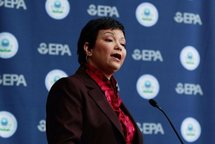US environmental agency gets tough on smog
AFP
WASHINGTON - The Environmental Protection Agency on Thursday proposed tougher standards for how much smog can be in the air, a move the US agency said would save money and protect health, especially in children.
"EPA is stepping up to protect Americans from one of the most persistent and widespread pollutants we face. Smog in the air we breathe poses a very serious health threat, especially to children and individuals suffering from asthma and lung disease," EPA Administrator Lisa Jackson said in a statement.

EPA Administrator Lisa Jackson
The new standards would replace those set by the previous administration, "which many believe were not protective enough of human health," the EPA said.
Under the new proposals, the "primary" standard for smog -- the standard to protect public health -- would be tightened to the strictest level ever in the United States -- between 60 and 70 parts per billion (ppb) measured over eight hours.
The administration of former president George W. Bush in 2008 set the primary standard for smog at 75 ppb for eight hours.
That level was judged too high by health and environmental groups, and a lawsuit was brought against the EPA in late 2008 in which joint complainants the American Lung Association (ALA) and Natural Resources Defense Council (NRDC) said a standard of 75 ppb ignored science and the law.
The ALA applauded Thursday's proposals in a statement posted on its website, and John Walke, a senior attorney at the NRDC, called them "very good news."
"They have put out a strong proposal consistent with the science to strengthen the smog standard," he told AFP, but added that environmental and health groups would "strongly urge" the EPA to set the smog limits at the lower level of 60 ppb rather than 70.
The numbers represent the pollution level at which air is deemed to be safe to breathe. In other words, under the current rules, set by the Bush administration, smog levels below 75 ppb are safe to breathe and levels above are unsafe.
A 60-day period for public comment has been opened and three public hearings will be held on the proposals, starting early next month.
If the lower level is passed, the savings to health care could be in the region of 100 billion dollars, as there would be fewer premature deaths, visits to the emergency room and days off work, and a drop in aggravated asthma and bronchitis cases, the EPA said.
The EPA also proposed Thursday setting a "secondary" standard designed to protect plants and trees from damage from repeated ozone exposure, which can reduce tree growth, damage leaves and increase susceptibility to disease.
Smog, which is also known as ground-level ozone, forms when emissions from industrial facilities, power plants, landfills and motor vehicles react in the sun.
The Sierra Club, a grassroots environmental group with 1.3 million members, called the proposals "a breath of fresh air" and applauded the EPA for "listening to health professionals and scientists and proposing a rule that provides real protection for millions of people."
"This rule will help ensure that all major sources of pollution get cleaned up," Sierra Club director Carl Pope said in a statement.
"It will drive the need for cities and states to reduce the smog pollution spewing from vehicle tailpipes -- investing in transportation choices that enable Americans to travel safely and efficiently without using their cars will be part of the solution," he said.
Once the levels are set, which experts believe will be later this year or early in 2011, states and the federal government will be required to outline comprehensive plans for how every sector -- from factories to public transportation to private cars to power plants -- will reduce pollution.
The aim is to have a concentration of ozone in the atmosphere of a given area that does not exceed the EPA-set level -- a "grace" period would allow areas to meet the new standards, with cities like Los Angeles, known for its clouds of smog, getting more time than less polluted cities such as New York or Washington.
---------------------------------------------------------------------------------------------------